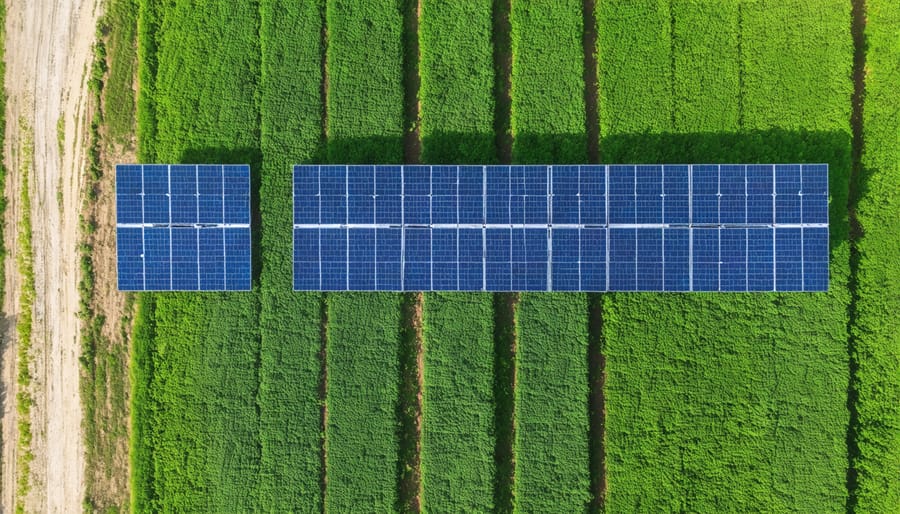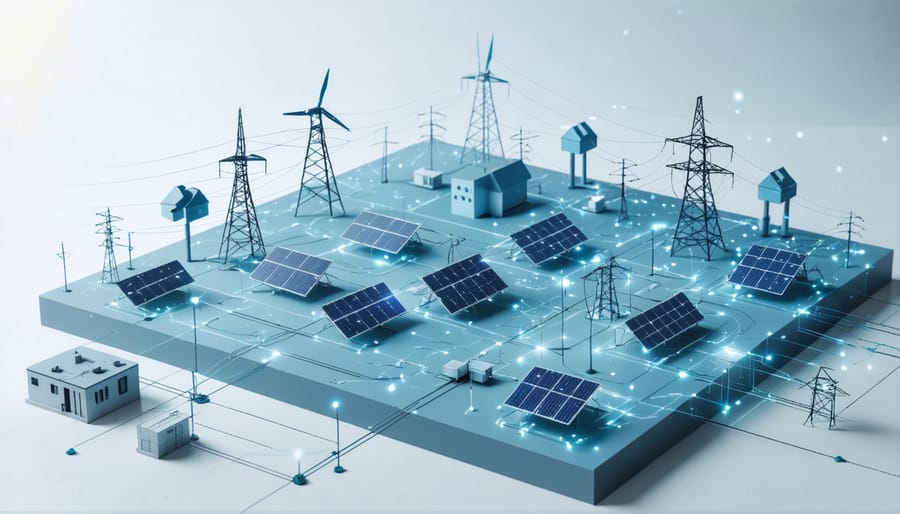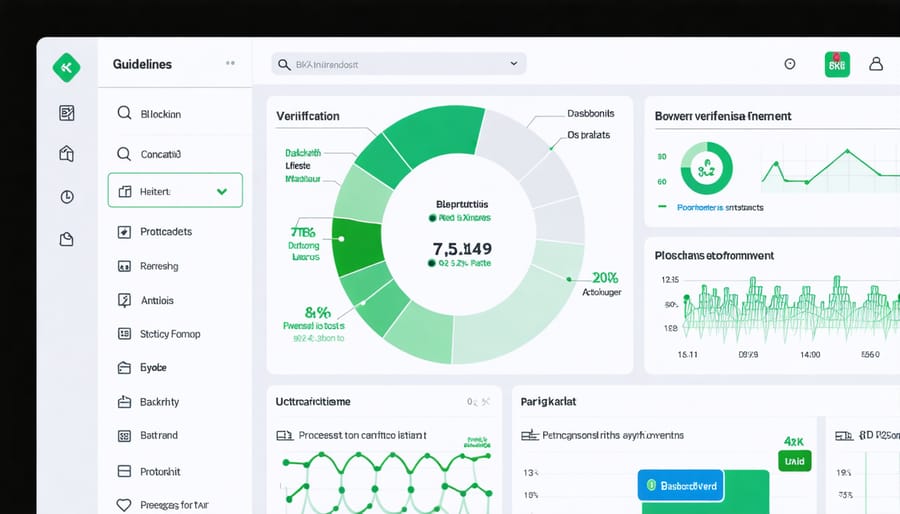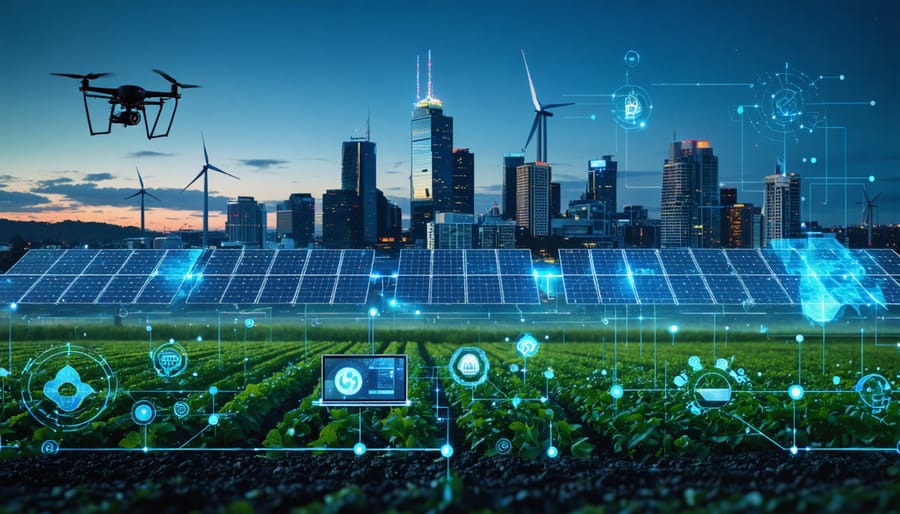Green innovation stands at the forefront of our global transition to a sustainable future, transforming traditional industries into eco-conscious powerhouses. From Sydney’s solar-powered skyscrapers to Melbourne’s waste-to-energy facilities, Australia leads breakthrough environmental technologies that are reshaping our economic landscape. These innovations aren’t just preserving our environment – they’re creating new markets, driving job growth, and establishing competitive advantages for forward-thinking businesses.
The convergence of artificial intelligence, renewable energy, and circular economy principles has unleashed unprecedented opportunities for sustainable development. Companies incorporating green technologies are seeing up to 30% reduction in operational costs while significantly decreasing their carbon footprint. This revolution spans across sectors, from agriculture’s precision farming techniques to manufacturing’s zero-waste production systems.
As we face increasing environmental challenges, green innovation offers practical solutions that benefit both planet and profit. Whether it’s blockchain-powered renewable energy trading or biodegradable packaging materials derived from agricultural waste, these advancements demonstrate how technology and sustainability can work in harmony to create a more resilient future. The green innovation wave isn’t just an environmental imperative – it’s becoming the primary driver of economic growth in the digital age.
Smart Agriculture Leads the Green Tech Wave

Precision Farming Technologies
Australian farmers are revolutionizing agriculture through innovative sustainable farming practices powered by cutting-edge technology. IoT sensors scattered across farmlands now act as vigilant guardians, monitoring soil moisture, nutrient levels, and weather conditions in real-time. These smart devices feed valuable data to farmers’ smartphones, enabling precise decision-making about irrigation and fertilization needs.
Drone technology has become a game-changer in modern farming, providing detailed aerial mapping that was once impossible to achieve. These eye-in-the-sky solutions create highly accurate 3D models of farmland, helping identify problem areas and optimize crop placement. Farmers can spot potential issues before they become visible from the ground, saving both time and resources.
Artificial Intelligence has transformed crop management from an art into a science. Machine learning algorithms analyze vast amounts of data from multiple sources – including satellite imagery, weather forecasts, and historical yield data – to predict optimal planting times and potential crop diseases. This technology helps farmers reduce water usage by up to 30% while increasing crop yields significantly.
These precision farming technologies aren’t just improving productivity; they’re creating a more sustainable agricultural sector. By minimizing resource waste and maximizing crop yields, Australian farmers are leading the way in smart, environmentally conscious farming practices that benefit both the land and their bottom line.
Biomass Integration Systems
In the heart of Australia’s agricultural regions, innovative digital platforms are revolutionizing how we transform farm waste into valuable energy resources. These smart systems are making bioenergy integration more accessible and efficient than ever before.
Take the story of the Murray-Darling Basin, where farmers are using AI-powered waste assessment tools to determine the optimal mix of crop residues for biogas production. These systems analyze moisture content, composition, and energy potential in real-time, maximizing conversion efficiency while minimizing environmental impact.
Smart logistics platforms are connecting agricultural producers with bioenergy facilities, creating a seamless supply chain that reduces transportation costs and carbon emissions. These digital marketplaces allow farmers to schedule collection times, track deliveries, and receive fair compensation for their biomass contributions.
Advanced monitoring systems are now essential components of modern biomass facilities. They use IoT sensors and machine learning algorithms to optimize the conversion process, adjusting parameters automatically to achieve the best possible energy yield. This technology has helped facilities increase their output by up to 30% while reducing operational costs.
The integration of these digital solutions isn’t just making biomass conversion more efficient – it’s creating new opportunities for rural communities. Local farmers are becoming energy producers, contributing to Australia’s renewable energy targets while developing additional revenue streams from what was once considered waste.
Digital Solutions Powering Clean Energy
Smart Grid Integration
In Australia’s push towards a greener future, smart grid integration represents a groundbreaking shift in how we manage and distribute bioenergy resources. These sophisticated digital systems act as the nervous system of our modern energy infrastructure, enabling real-time monitoring, efficient distribution, and dynamic load balancing of renewable energy sources.
The integration of smart meters and IoT sensors across the network allows for unprecedented control over bioenergy distribution. For instance, in South Australia’s Adelaide Hills region, smart grid technology has enabled local biomass plants to adjust their output based on immediate community needs, reducing waste and improving overall system efficiency by up to 40%.
These intelligent systems also facilitate two-way communication between energy providers and consumers, creating what industry experts call the “Internet of Energy.” Households can now monitor their energy consumption patterns, receive instant feedback, and make informed decisions about their usage. The Western Sydney Smart Grid Initiative demonstrates how this technology helps balance supply and demand, particularly during peak usage periods.
Machine learning algorithms within these smart grids continuously analyze consumption patterns, weather data, and grid performance to optimize distribution. This predictive capability has proven particularly valuable during bushfire seasons, when the grid can automatically reroute power from bioenergy sources to maintain essential services in vulnerable areas.
Looking ahead, smart grid integration is paving the way for virtual power plants (VPPs), where multiple bioenergy sources can be coordinated as a single entity. These systems are already being trialed in Queensland, where agricultural waste-to-energy plants are working in concert with traditional renewable sources to provide stable, sustainable power to remote communities.

AI-Powered Energy Management
Artificial intelligence is revolutionising how Australia harnesses and distributes renewable energy, creating smarter and more efficient power systems across the continent. From Sydney’s bustling CBD to remote solar farms in the Outback, AI algorithms are working behind the scenes to optimise energy flow and reduce waste.
Smart grid systems equipped with AI can now predict energy demand patterns with remarkable accuracy, allowing power providers to adjust supply in real-time. For instance, the Victorian Smart Grid Partnership has implemented machine learning algorithms that analyse weather patterns, historical usage data, and local events to forecast energy needs up to 48 hours in advance, reducing grid stress during peak periods.
These intelligent systems are particularly valuable for managing intermittent renewable sources like solar and wind power. In South Australia, where wind farms generate a significant portion of the state’s electricity, AI systems help balance supply fluctuations by automatically adjusting storage systems and distribution patterns. This has resulted in a 15% improvement in renewable energy integration and significantly fewer instances of grid instability.
The technology extends to the household level, where smart meters and AI-powered home energy management systems help families optimise their power usage. These systems learn household routines and automatically adjust heating, cooling, and appliance use to minimise waste while maximising the use of solar power during peak generation hours.
Looking ahead, AI is set to play an even more crucial role in Australia’s renewable energy future. Projects are underway to develop advanced predictive maintenance systems for wind turbines and solar arrays, using machine learning to detect potential failures before they occur and optimise maintenance schedules, ultimately reducing downtime and increasing energy generation efficiency.
Real-Time Environmental Monitoring
Emission Tracking Platforms
In today’s digital landscape, emission tracking platforms have emerged as powerful tools for businesses and organizations committed to reducing their environmental impact. These innovative solutions combine advanced sensors, artificial intelligence, and cloud computing to provide real-time monitoring of carbon emissions across various operations.
Australian companies are increasingly adopting these platforms as part of their broader circular economy initiatives, with remarkable results. For instance, the Melbourne-based Carbon Analytics Platform has helped local manufacturers reduce their emissions by up to 25% through precise monitoring and targeted interventions.
These platforms typically feature user-friendly dashboards that display emissions data in easily digestible formats, enabling organizations to identify hotspots and implement immediate corrective actions. Smart algorithms can predict future emission patterns and suggest optimization strategies, while mobile apps allow field workers to input data and track progress on the go.
What sets modern emission tracking platforms apart is their integration capabilities. They can connect with existing business systems, from supply chain management to building automation, creating a comprehensive view of an organization’s carbon footprint. This interconnected approach helps businesses make informed decisions about their sustainability efforts and demonstrates tangible progress toward their environmental goals.
Looking ahead, these platforms are incorporating blockchain technology to ensure data transparency and artificial intelligence to provide more sophisticated recommendations for emission reduction strategies.
Blockchain for Sustainability
Blockchain technology is revolutionising how we track and verify environmental initiatives across Australia. By creating immutable digital records, blockchain provides unprecedented transparency in renewable energy trading and carbon credit verification. Leading energy providers are already implementing blockchain solutions to ensure that green energy certificates accurately represent real renewable power generation.
In Queensland, several solar farms have pioneered blockchain-based tracking systems that verify every kilowatt-hour of clean energy produced and traded. This technology enables consumers to confidently purchase renewable energy with complete certainty about its origin and environmental impact. Similarly, carbon offset programs are using blockchain to eliminate double-counting and ensure the authenticity of environmental credits.
The impact extends beyond energy markets. Agricultural enterprises are using blockchain to verify sustainable farming practices and organic certification. Forest conservation projects are tracking tree plantings and biodiversity outcomes through distributed ledger systems, providing donors and investors with reliable proof of environmental benefits.
Looking ahead, blockchain is set to transform environmental compliance monitoring. Smart contracts automatically verify and report compliance with environmental regulations, reducing administrative burden while increasing accountability. Several councils are trialling blockchain-based systems for waste management tracking and recycling verification, creating a more transparent and efficient circular economy.
This digital infrastructure is particularly valuable for Australia’s ambitious renewable energy targets, providing the trust and transparency needed to accelerate green innovation across sectors.

The Future of Green Digital Innovation
Next-Generation Green Tech
The digital revolution is ushering in a new era of sustainable technology that’s transforming how we approach environmental challenges. Smart sensors and artificial intelligence are now being deployed across Australian cities to optimise energy consumption and reduce waste in real-time. These systems can predict peak usage periods and automatically adjust power distribution, resulting in significant energy savings.
Blockchain technology is revolutionising renewable energy trading, enabling households with solar panels to directly trade excess power with neighbours through peer-to-peer networks. Meanwhile, quantum computing developments are accelerating the discovery of new materials for more efficient solar panels and energy storage solutions.
Advanced biotechnology is producing breakthrough innovations in carbon capture, with engineered microorganisms capable of converting CO2 into useful products. In agriculture, precision farming robots powered by machine learning are reducing water usage and minimising pesticide application while maximising crop yields.
Perhaps most exciting is the emergence of self-healing materials that can repair environmental damage automatically, and biodegradable electronics that leave no toxic waste behind. These innovations aren’t just concepts – they’re being tested and implemented across Australia, paving the way for a more sustainable future.
Australian Innovation Hub
Australia has emerged as a powerhouse in green digital innovation, pioneering solutions that combine technological advancement with environmental stewardship. From Sydney to Perth, innovation hubs are fostering groundbreaking developments in renewable energy tracking, smart agriculture, and sustainable urban planning.
The Green Tech Hub in Melbourne exemplifies this progress, where startups are developing AI-powered solutions for reducing carbon emissions in manufacturing. These innovations have attracted significant sustainable investment opportunities, driving the nation’s transition to a cleaner future.
Notable achievements include the development of blockchain-based renewable energy trading platforms in South Australia and smart water management systems in Queensland that reduce waste by up to 30%. The Sydney Innovation Centre has pioneered solar forecasting technology that helps grid operators optimize renewable energy integration.
These initiatives are supported by collaboration between universities, industry leaders, and government bodies, creating a robust ecosystem for green innovation. With continued investment in research and development, Australia is positioned to become a global leader in sustainable digital solutions, offering practical answers to pressing environmental challenges.
Australia’s digital transformation towards a greener economy stands as a testament to our innovative spirit and commitment to sustainability. The convergence of digital technologies and environmental solutions has created unprecedented opportunities for reducing carbon emissions while boosting economic growth. From smart farming practices revolutionizing agricultural sustainability to AI-powered renewable energy systems optimizing power distribution, these innovations are reshaping our approach to environmental challenges.
The impact of these digital green initiatives extends beyond immediate environmental benefits. We’re witnessing the emergence of new industries, creation of sustainable jobs, and development of exportable green technologies that position Australia as a global leader in environmental innovation. Start-ups and established companies alike are finding innovative ways to merge digital capabilities with sustainable practices, creating solutions that are both environmentally responsible and commercially viable.
Looking ahead, the future of Australia’s green economy appears promising. The continued advancement of technologies like blockchain for carbon trading, IoT for environmental monitoring, and machine learning for resource optimization suggests we’re only scratching the surface of possible innovations. With increased investment in research and development, supportive government policies, and growing public awareness, we’re well-positioned to accelerate our transition to a sustainable future.
The success of our green innovation journey will depend on maintaining this momentum, fostering collaboration between sectors, and ensuring these digital solutions remain accessible and practical for businesses and communities across the country. As we face global environmental challenges, Australia’s commitment to digital green innovation sets an inspiring example for others to follow.

